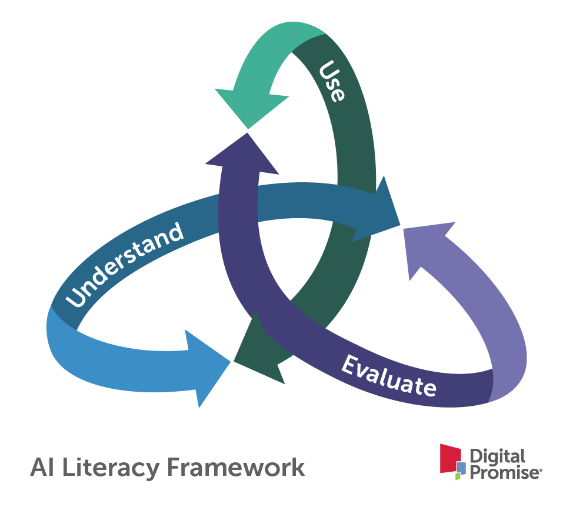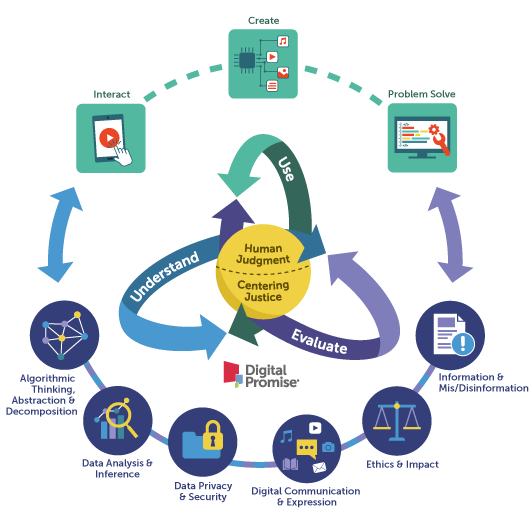AI literacy is the knowledge and skills that enable humans to critically understand, evaluate, and use AI systems and tools to safely and ethically participate in an increasingly digital world.

Figure 1. AI Literacy Framework includes three components: Understand, Evaluate, and Use

In the center of the expanded framework image is a 3D triangular diagram with three bidirectional arrows. The bottom left arrow is blue and labeled ‘understand’, the bottom right arrow is purple and labeled ‘evaluate’, and the top arrow is green and oriented vertically, labeled ‘use’. At the center of the three bidirectional arrows is a yellow sphere with the text "Human Judgment" on the top half and "Centering Justice" on the bottom half. Surrounding the sphere and arrows are icons arranged in a circle formation. The top three icons correlate to types of ‘use’ and have a green background, connected with a green dotted line. The icons represent ‘interact,’ ‘create,’ and ‘problem solve.’ The bottom six icons represent AI literacy practices for ‘understand’ and ‘evaluate’ with an indigo background, connected with an alternating blue and purple dashed line. The icons represent ‘data privacy & security,’ ‘ethic & impact,’ ‘digital communication & expression,’ ‘information & mis/disinformation,’ ‘data analysis & inference,’ and ‘algorithmic thinking, abstraction, & decomposition.’ The top three green icons and the bottom six indigo icons are connected with a bidirectional blue arrow on the left and a bidirectional purple arrow on the right.
| Framework Component | Description | Examples |
|---|---|---|
|
AI Literacy Practices |
Actionable practices of understand and evaluate that learners can demonstrate |
Data Privacy & Security, Information & Mis/Disinformation |
|
Core Values |
Underlying principles that support learners to safely and effectively use AI tools |
Human Judgment, Centering Justice |
|
Modes of Engagement |
Interconnected ways users can engage with AI-enabled tools in order to demonstrate AI literacy |
Understand, Evaluate, Use |
|
Types of Use |
Distinct purposes for which users engage with AI-enabled tools |
Interact, Create, Problem Solve |
| Framework Component |
AI Literacy Practices |
|---|---|
| Description |
Actionable practices of understand and evaluate that learners can demonstrate |
| Examples |
Data Privacy & Security, Information & Mis/Disinformation |
| Framework Component |
Core Values |
| Description |
Underlying principles that support learners to safely and effectively use AI tools |
| Examples |
Human Judgment, Centering Justice |
| Framework Component |
Modes of Engagement |
| Description |
Interconnected ways users can engage with AI-enabled tools in order to demonstrate AI literacy |
| Examples |
Understand, Evaluate, Use |
| Framework Component |
Types of Use |
| Description |
Distinct purposes for which users engage with AI-enabled tools |
| Examples |
Interact, Create, Problem Solve |